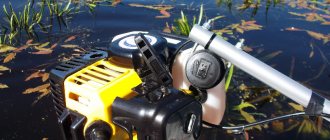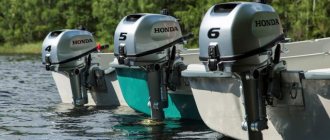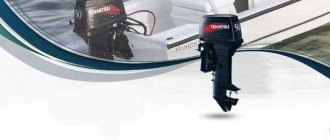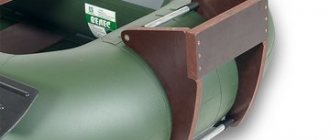The question of fuel consumption by a boat engine falls into the category that interests many owners of small boats.
When purchasing such an engine, a potential buyer is most often interested in data about its cost, boat speed and fuel consumption.
And if the issue of cost is decided at the place where the motor is purchased, and the speed depends on the type of boat and motor power, then data on fuel consumption is much more difficult to obtain.
Unlike cars, for which fuel consumption is measured in liters per 100 km traveled, the fuel consumption of a boat engine is measured differently.
A car is developed for a specific engine and fuel consumption depends only on the engine-body combination, which remains unchanged throughout the entire period of its operation.
In addition, the heavy weight of the car and solid engine power minimize the influence of weather conditions, the weight of passengers and luggage.
As for boats equipped with two- or four-stroke power plants, when moving on the water surface, they are exposed to a large number of different factors.
In addition to the type and weight of the boat on which the motor is mounted, fuel consumption is significantly affected by :
- Headwind or tailwind.
- Moving with or against the current.
- Boat load.
- Driving mode – planing or displacement.
Examples of consumption from various manufacturers
Examples of hourly and specific fuel consumption by boat power plants of various brands are given in many specialized publications and on numerous websites of companies selling this type of product.
They are presented in the form of tables or graphs compiled from the results of testing a large number of a wide variety of engines.
These data, without claiming to be the truth in the first instance, can help the owner of a boat motor determine the amount of fuel that needs to be taken with them when going fishing or traveling.
Let's look at the statistics of the most popular motors, such as:
Yamaha
Two-stroke:
- Power range , hp: 2.5…30.
- Range of changes in fuel consumption, l/hour: from 1.7 to 11.5.
Four-stroke:
- Power range , hp: 4…40.
- Range of changes in fuel consumption, l/hour: from 1.7 to 14.5.
Mercury
Two-stroke:
- Power range , hp: 2.5…40.
- Range of changes in fuel consumption, l/hour: from 1.5 to 17.
Four-stroke:
- Power range , hp: 2.5…30.
- Range of changes in fuel consumption, l/hour: from 1 to 10.
Suzuki
Two-stroke:
- Power range , hp: 15…40.
- Range of changes in fuel consumption, l/hour: from 3.47 to 9.24;
Four-stroke:
- Power range , hp: 2.5…40.
- Range of changes in fuel consumption, l/hour: from 0.5 to 6.6.
Tohatsu
Fuel consumption of Mercury and Tohatsu (two-stroke)
Two-stroke:
- Power range , hp: 2.5…40.
- Range of changes in fuel consumption, l/hour: from 1.7 to 17.
Four-stroke:
- Power range , hp: 2.5…30.
- Range of changes in fuel consumption, l/hour: from 1.2 to 10.
Factors influencing the choice of outboard motor
Engine power
It is very important here to combine the power of the motor with the size of the craft. In no case should you overestimate the engine power, as the boat will be too maneuverable and difficult to control. If there is not enough power, the boat will not have sufficient speed, the engine may fail prematurely, and fuel consumption will be maximum.
It is important to know! The power of a boat motor is calculated using the following simplified data: for 25 kg of weight there should be about 1 horsepower. For punts a little more - 30 kg of weight.
Fuel consumption
Naturally, everyone is interested in this issue, and there are a number of indicators that have a significant impact on such characteristics:
- Company manufacturer.
- What kind of engine is it - two-stroke or four-stroke?
- Carburetor or injection.
- Examples of calculations. They partially influence this indicator.
Quality, price and efficiency are the indicators that correspond to outboard motors from Japanese manufacturers, such as models from Yamaha, Suzuki, Honda, Tohatsu, etc. Mercury is an American manufacturer that is practically in no way inferior to the Japanese ones. As for domestic manufacturers, engines such as Whirlwind, Veterok, Kama, Neptune and others do not yet meet such requirements. Although they are cheaper, their fuel consumption is significant, and the diagnostic system is noticeably weaker.
If we take the Veterok outboard motor as an example, it consumes 3.2 liters of gasoline with a power of 8 hp. and 5 liters - with a power of 12 hp.
Comparison of boat motors ➡️ 2 or 4 strokes? We measure fuel consumption while driving.
Therefore, it is better to focus on Japanese companies:
YAMAHA
It has been on the boat motor market since the 60s of the last century.
This is a well-known Japanese company that produces not only boat motors, but also many other products that also meet high quality standards.
The company specializes in the production of powerful motors for boats and yachts. Two-stroke models consume from 27 to 40 liters per hour, and four-stroke models - in the range of 10-130 liters per hour. The table shows fuel consumption depending on the power of engines intended for use on boats weighing up to 500 kilograms.
| Power | fuel (liters hour) |
| 4 horsepower | 1.45 liters |
| 5 l. With. | 1.80 l |
| 6 l. With. | 2.40 l |
| 8 l. With. | 3.20 l |
| 9.9 l. With. | 3.60 l |
| 15 l. With. | 5.40 l |
| 20 l. With. | 6.40 l |
SUZUKI
For the same time as YAMAHA, it has been producing outboard motors.
Two-stroke engines are equipped with two tanks - for gasoline and for oil, and mixing is carried out automatically. Depending on the power, gasoline consumption ranges from 7.5 to 44 liters. at one o'clock. Four-stroke engines are more economical and consume from 0.6 to 15 liters.
| Power | fuel (liters hour) |
| 2.5 l. With. | 0.95 l |
| 4 l. With. | 1.50 l |
| 6 l. With. | 2 l |
| 9.9 l. With. | 3.80 l |
| 15 l. With. | 4.90 l |
Mercury
Mercury company produces boat motors, and they are no less economical than Japanese companies. Their two-stroke models consume from 0.8 to 50 liters, and four-stroke models consume even less - from 0.5 to 24 liters.
| Power | fuel (liters hour) |
| 3.5 l. With. | 1,40 |
| 4 | 1,50 |
| 6 | 2,0 |
| 8 | 3,20 |
| 9,9 | 3,80 |
| 15 | 5,10 |
HONDA
It also boasts low fuel consumption, producing engines with power from 2 to 225 hp. At the same time, two-stroke models consume from 0.64 to 72 liters, and four-stroke models - from 0.5 to 56 liters.
| Power | fuel (liters hour) |
| 2,3 | 0,95 |
| 5 | 1,80 |
| 8 | 3,20 |
| 9,9 | 3,80 |
| 15 | 4,90 |
| 20 | 6,40 |
Fuel consumption of two-stroke engines
The domestic market offers fans of fishing and motorboating two-stroke engines that do not have the disadvantages of carburetor engines of previous years.
Today, well-known manufacturers (Evinrude, Mercury Marine, etc.) equip their engines with modern direct fuel injection systems.
Direct injection of a certain amount of fuel into the combustion chamber of each cylinder ensures its complete combustion with virtually no losses.
However, in order to further reduce fuel consumption, especially at low speeds (main operating mode), manufacturers have developed a stratified injection system.
By using the on-board computer to determine how much energy is needed to move the boat, this innovative system delivers only the required amount of fuel to the engine.
Considering that the system operates in real time, and engine power is not significant, very efficient use of fuel at low speeds is achieved.
Engine fuel consumption
The issue of engine fuel consumption is an eternal hot topic for almost all boaters. Calculating how much fuel your boat will consume is not so easy. Here, as mentioned, several important factors are at work. But there are obvious and well-known nuances that are very important to take into account:
- It is clear that you will immediately understand the issue of the cost of a particular boat unit when purchasing an engine. Its power, in turn, will depend on the type of specific small boat and the power of your inboard or outboard boat engine. But the information that will tell you how your boat burns is much more difficult to obtain;
- as you know, for motor vehicles, in which fuel consumption is measured in liters per 100 kilometers of travel, the fuel consumption of the engine for the boat will be measured in a completely different way;
- the machine is designed for one or another specific engine for water transport. That is why the combustion of fuel in it will depend on indicators such as the engine and the body, which interact with each other throughout the entire journey. Also, the large mass of the car and a sufficiently large motor power will minimize the influence of certain climatic data, as well as the mass of the cargo and those on board the boat;
- If we talk about two-stroke and four-stroke outboard engines, then it will be a completely different matter. When moving through water, they are influenced by a number of factors.
We recommend reading: Features of operation of Nissan Marine outboard motors
Evgeniy Bronov
auto RU
Here are some of the important factors that have a significant influence on this issue: the wind, and it affects both the headwind and the tailwind that your ship meets, it is important whether you are moving with the current or against it, the workload of your boat is also important. transport and traffic mode. Boats have different types of propulsion, such as planing and displacement.
Also, in addition to these important factors that can radically change your path and the amount of fuel that will last you for some time, the type and weight of the boat on which the motor is directly attached is also important.
Fuel consumption of four-stroke engines
When choosing a four-stroke outboard motor, fuel consumption is also of no small importance.
Recently, the manufacturers of these engines have managed to solve a number of problems that have a certain impact on this parameter.
Among them:
- Insufficient maximum torque at low speeds.
- Delayed throttle response.
These problems were solved by using the latest scientific achievements in the design of boat engines.
Currently, almost all manufacturers equip their four-stroke power plants with computer electronic systems:
- Throttle control.
- Shifting gears.
Leading manufacturers are actively introducing original systems of their own design into production.
Equipping the engines allows you to ensure efficient use of fuel:
- Mercury Verado - electronic variable valve timing system.
- Honda - electronic valve control system.
In addition, leading manufacturers install direct injection systems in four-stroke engines, similar to those used in two-stroke engines.
At the same time, research in the field of increasing fuel efficiency continues.
Suuzuki company:
- Uses an injection system that operates without a battery.
- She has developed an innovative technological process for using lean mixture in low-power power plants (up to 20 hp).
Honda has developed the original LEANburn Control fuel supply system. This allows engines equipped with such a system to automatically determine the optimal composition of the fuel-air mixture for any change in thrust.
Thus, savings of up to 25% are achieved.
However, the use of computer systems has to some extent complicated the already quite complex maintenance of four-stroke engines.
If the owner can change the oil and filters himself, then all other operations should be performed by a qualified mechanic.
Yamaha 15 FMHS outboard motor control
However, the growling two-stroke Yamaha 15 FMHS is quite easy to control.
The tiller is equipped with a gas handle. There is a choice of driving direction: forward-neutral-backward. In addition, the well-thought-out design of mounting the outboard motor on the transom creates good conditions for tacking.
The engine turns left and right, reclines and is fixed above the transom if necessary to cross shallow water or moor to the shore.
Outboard motor fuel consumption
Calculation of data characterizing fuel consumption by outboard boat motors is always quite subjective and relative.
Therefore, statistical indicators given in various publications often contradict each other.
It must be remembered that fuel consumption in boat engines is calculated in kg/hour, and it is sold at gas stations in liters.
Therefore, inattention at a gas station can lead to the fact that the fuel tank is empty somewhere in the middle of the pond. After all, the weight of 1 liter of gasoline, depending on the brand, is 0.71 - 0.76 kg.
What determines fuel consumption?
Firstly, fuel consumption depends on the model of the outboard motor, which is also related to the manufacturer.
Choosing the right model is a guarantee of successful and comfortable fishing, as well as minimal maintenance and fuel costs.
Therefore, we can safely say that gasoline costs depend on the correct choice of engine.










